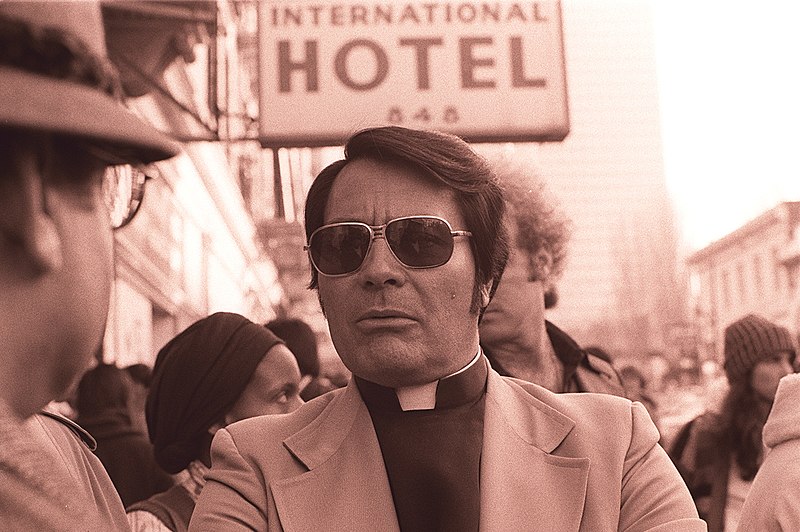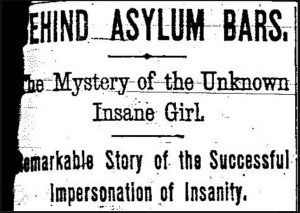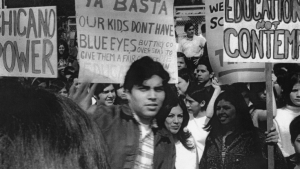Have you ever heard of the Kool-Aid Massacre? Where one mind-controlling, manipulating man led to hundreds to their deaths? Throughout the 20th century, numerous cults shaped America’s history in terrifying ways. Some of the most memorable have been the Manson Family, Heaven’s Gate, and The People’s Temple Agricultural Project. It takes a second when someone hears The People’s Temple to remember what happened, but usually mentioning the Jonestown Massacre helps them recall the terrors that happened that day.
Jim Jones, a preacher, started The People’s Temple Agricultural Project in the mid-1950s while residing in Indianapolis. The goal of the organization was to fight against racism and poverty, and Jones’ followers were primarily African Americans. Jones believed in Christianity and socialism. His organization “…was dedicated to the pursuit of social justice along Marxist lines.”1 He thought it was unfair that the rich were able to be happy and living a wonderful life while the poor or racially discriminated endured a life of hardships. He believed everyone deserved equality. Jones called his mission “apostolic socialism” through Marxist theology. He invented this term as a way to describe his church as something that used faith healings alongside an upbeat style from black churches. He began to become more demanding of his followers, insisting they call him “father” or “dad.”2 This was the first step in how Jones’ demands would become more of a problem.

Jones eventually moved the organization to Redwood, California because of his growing population of followers. He began calling the organization a church. Eventually he created churches in Los Angeles and San Francisco, where he later moved the his headquarters. He opened up churches in black communities around San Francisco to gain more followers.3 Jones became so popular that he was elected a chairman of the San Francisco Housing Authority Commission.4 This gave him more power and notoriety among the general population. With this much power, expressing his ideas increased the followers he gained. He climbed his way up and made himself a powerful, controlling man through his charisma and ideology. This led to the rise of popularity of his church and influenced even more people to join.
Cults became increasingly popular in America throughout its history because people have found them appealing to their beliefs and values. Some join due to the cult believing in the same values or having the same desires for changes to political or racial relations. Many cults are considered as religious or political based on their values. There are 600 different alternative religions in America and Canada alone that can be considered cults.5Many of the cults in the past represented some part of a countercultural movement happening within America during the late 20th century. John R. Hall, an American author, wrote, “the radical Left and counterculture’s emergence in the 1960s did not go unchallenged. Rather there was a broad-based reaction- on cultural, social, and political fronts.”6 The appearance of cults became more apparent during this time due to the political and social movements that were happening in America. People who were thought of as a minority or people from a lower social class wanted change. These people wanted change so badly that they willingly believed in anyone charismatic enough and who promised to give them what they wanted whether it be money or equality.7
As the People’s Temple grew, the larger population of San Francisco became worried about the church and its preachings. The citizens thought it was strange that the church employed armed guards at all times.8 Accusations spread about the organization participating in financial fraud and abusing some of its members. New West Magazine described Jones as a sexual predator and drug user. The magazine also stated that Jones faked ceremonies where he healed his followers, and he scammed his followers out of their money.9

While being investigated for these accusations and crimes, Jones decided to move his church to Guyana in South America after discussing with his followers. One of his followers suggested Guyana because of the black, socialist leaders in charge of the country. Jones and his followers thought because of that, they would be able to live peacefully in Guyana.10 After all Jones’ followers moved to Guyana, family members became concerned since Jones would not allow followers to communicate with their families in the United States. These family members begged California congressman Leo Ryans to take a trip to Jonestown and bring home their family members. The congressman agreed to take a trip to figure out what was happening after the death of a former temple member who previously spoke about leaving the church. The congressman’s suspicions rose, and he felt he needed to investigate for himself. The trip started out going extremely well. Jones welcomed Congressman Leo Ryan. Jones invited him to have food and attend a musical rehearsal. According to sources, all the followers forcefully pretended to be happy and pretended everything was going fine while the congressman was there. Some families who asked congressman Ryan to take them back to the United States with him. Jones became furious and secretly devised a plan that was the starting point of the deaths for many.11
By promising their followers a new way of life, cult leaders gain a type of control over members’ minds and lives themselves. There is a stereotype within cults that leaders use brainwashing or mind control on their followers in order to fulfill their selfish wants.12 Some cult members lie and pretend to have psychic readings and psychic healings. This leads many people to believe in these leaders and start giving complete devotion to them. Followers begin to see their leader as a “Living God.” This leads to followers enduring physical pain and abuse to show their dedication. There are several ways followers expressed this in the past such as depriving themselves of sleep or not eating the proper nutrients needed for their body.13 If a follower refuses to comply with showing their devotions in such ways or simply want to live the group, leaders execute them. One survivor notes how he wanted to leave, and he received a choice of either being shot or drink poison. Although he escaped, not many were as lucky.14 Eventually this leads to the last devotion any follower gives their leader, their life.
Due to the concern that arose, Congressman Leo Ryan agreed that the people wanting to go home may go with him. Jones showed no anger while Congressman Ryan was there. As soon as he left to his plane, Jones ordered for all of the ones leaving to be killed. There was nine members who went to shoot everyone who decided to leave. Everyone died including Congressman Leo Ryan, who was shot over twenty times.15 Not long after, Jones planned a mass-suicide for all the members to join in. The majority of the members participated in drinking poisoned punch. The children, unaware, drank the poisoned punch first, and then the adults drank the punch next. Armed guards stood ready to shoot if members refused to participate. Guards shot all of the members who tried running away. This resulted in over 900 deaths.16 Jones coined the event as “revolutionary suicide,” and it received the nickname “Kool-Aid Massacre.” These events took a toll on American citizens as it was one of the largest mass killings in history at the time.17

The sad truth is that some of these American cults ended in the death of hundreds. As a last step to show their devotion to their leader, followers willing participate in committing suicide or committing mass murder. This could be done in numerous way such as either injecting themselves or others with poison or killing and taking the lives of innocent people. 18 The followers believe they are proving themselves worthy to their leader by giving this last devotion of taking their lives or others. This ultimately gives the leader the last control over the follower’s lives.
Even though the event that took place was a tragedy, some members escaped and survived the mass-suicide. Jim Jones was found dead with a shot to his head, but there is no evidence to know if he killed himself or if someone else killed him. The rest of the members that resided in California eventually ended the organization. The members that survived went on to tell their stories and how Jim Jones controlled and acted.19 The actions of Jim Jones led to the loss of hundreds American lives in total. Even though these events happened forty-one years ago, it still is one of the most tragic events to happened in America’s history.
- Salem Press Biographical Encyclopedia, 2019, s.v. “Jonestown and the People’s Temple,” by Joseph P Byren. ↵
- Richard Cavendish, “The Jonestown Mass Suicide,” History Today 58, no. 11 (2008): 13. ↵
- Salem Press Biographical Encyclopedia, 2019, s.v. “Jonestown and the People’s Temple,” by Joseph P Byren. ↵
- Wikipedia, 2019, s.v. “Jonestown.” https://en.wikipedia.org/wiki/Jonestown. ↵
- Robert Emmet Long, Religious Cults in America (New York: H.W. Wilson, 1994), 75. ↵
- John R. Hall, “Jonestown in the Twenty-First Century,” Society 41, no. 2 (2004) 9. ↵
- James R. Lewis, Cults in America : A Reference Handbook (California: ABC-CLIO, 1998) 18. ↵
- Salem Press Biographical Encyclopedia, 2019, s.v. “Jonestown and the People’s Temple,” by Joseph P Byren. ↵
- Richard Cavendish, “The Jonestown Mass Suicide,” History Today 58, no. 11 (2008): 13. ↵
- Wikipedia, 2019, s.v. “Jonestown.” https://en.wikipedia.org/wiki/Jonestown. ↵
- Wikipedia, 2019, s.v. “Jonestown.” https://en.wikipedia.org/wiki/Jonestown. ↵
- James R. Lewis, Cults in America : A Reference Handbook (California: ABC-CLIO, 1998) 39. ↵
- Robert Emmet Long, Religious Cults in America (New York: H.W. Wilson, 1994), 16. ↵
- Robert Emmet Long, Religious Cults in America (New York: H.W. Wilson, 1994) 17. ↵
- Wikipedia, 2019, s.v. “Jonestown.” https://en.wikipedia.org/wiki/Jonestown. ↵
- Salem Press Biographical Encyclopedia, 2019, s.v. “Jonestown and the People’s Temple,” by Joseph P Byren. ↵
- Wikipedia, 2019, s.v. “Jonestown.” https://en.wikipedia.org/wiki/Jonestown. ↵
- Robert Emmet Long, Religious Cults in America (New York: H.W. Wilson, 1994), 17. ↵
- Wikipedia, 2019, s.v. “Jonestown.” https://en.wikipedia.org/wiki/Jonestown. ↵



49 comments
Lorena Martinez Canavati
I knew about the Jonestown Massacre because I had read about it before. It amazed me because it made me think: how can people trust someone so much to literally sacrifice their lives for a “preacher”? I guess the times made it easier because of what was going on with minorities and racism, but still, after seeing that this man had to run away to Guyana because he was being investigated, why did his victims follow him? I guess because they really saw him as a God of some sort. It’s really impressive to see that some people, being very charismatic and charming, can really control others and trick them into doing certain things, like the Manson murders. I think the article was very short and not really that descriptive but it summarized everything well.
Dylan Miller
I learned about the horrifying story of Jonestown from a documentary I saw in my victimology class, and it left me shocked. The way that Jim Jones led all those people into some camp thousands of miles away from their homes all because he was charismatic and told the people what they wanted to hear is absolutely insane! Over 900 people dead from poisoning, including children, all willingly drinking what was drinking to them thinking it was their salvation, is absolutely disheartening to hear. These people were willing to kill their children, or their partners if they even dare talk bad about Jones, and called them traitors, which is scary to think about! There’s a reason why the saying “too good to be true” is extremely prevalent in recent times, it’s because of cases like these where people idolize and follow Jim Jones no questions asked because of the promises he provided, and the charismatic tone in his voice.
Mckenzie Gritton
Such a sad story. The fact that so many people listened to and believed in this man is beyond me. Its scary that there are people out there that are so charismatic that they can invoke people to do things like this or to even kill. Then there’s those poor kids who were so innocent in all of this and they were one of the firsts to lose their lives.
Charles Lares
Jim Jones was a a charismatic man as for many of the cult leaders. Jones was a man of a God complex, he wanted his worshippers to see him as a God and devote their life to him. It was such a tragedy to see many worshippers die by suicide but it was even worse when Jones made them drink the kool-aid or have them shot by his guards, those fortunate to live to tell the story of one of the worse events in history will always be sad because it really shows how one charismatic person can change one’s life forever.
Trenton Boudreaux
A very interesting read. Strange to see how a group with a noble goal, racial and wealth equality, would end up turning into a fanatical cult, as when one thinks religious extremism, you usually assume they are right leaning. I had never heard of Jonestown before this, so this was all new information to me. Besides from a few errors in grammar and spelling, the article was well written.
Desiree Arizmendez
I have never heard of the Jonestown massacre. It is very crazy how far people take their worships to a new level. I could never understand how people would give their lives to show how much they believe in something. Reading this article really showed me how much people will believe one person who seems to cater to their needs, and how that one person have so much hate to bring down so many people for their self interest. Truly an evil thing to happen to many people.
Madelynn Vasquez
The tragedy of the Jonestown Massacre is still unbelievable and disturbing to this day. I watched a documentary on this back in high school and refreshing my memory with this article, I was still shocked now just as I was before. It still baffles me how people will blindly follow others with no questions asked and to know that so many ended up committing suicide or mass murder like a final rite of passage, makes me sick to my stomach. It makes you wonder how someone like Jim Jones, or anyone for that matter, could ever commit such heinous acts… by far one of the worst tragedies in American history and may those people and their families rest peacefully.
Reagan Clark
I actually just heard about this massacre when I was visiting California last month. I was in the area of one of the cult’s former locations. My Uncle was explaining the whole cult to us. He even mentioned that there was a song named after this massacre called “Guyana Punch.” I wonder what makes people so devoted to one person that they would kill their children and commit suicide for them. It is truly disturbing.
Abilene Solano
This was a truly tragic story, it shocks me about how much people are willing to show their devotions to others. They are willing to give up their lives just to show their loyalty while others who slightly hesitate are considered traitors and are automatically killed. While reading this article, the photograph after the Jonestown Massacre gave me chills because it didn’t dawn to me that was was surrounding the building was hundreds of dead bodies. It saddens me even more knowing that there was children involved who unknowingly drank poison just because they were told to. I never heard about the Jamestown massacre so reading this article really opened my eyes about the evils of society can do to you once someone abuses their power in what others should believe in or when finding their purpose in life.
Citlalli Rivera
I find it very upsetting that Jims Jones used racial and social equality as a guise to feed his ego and gain loyal followers. I wonder if he actually had good intentions from the start or if he only used social change as a motivator for people to follow him. I heard about this story once in a podcast and the commentator said she refuses to call it a mass-suicide and instead calls it a mass-murder because the cult members either unknowingly drank the punch or were forced into doing so. Calling it a mass-suicide brings an entirely different connotation to the lives lost at the hands of Jim Jones. Overall, this was a great article and it did a good job of highlighting an interesting story in American history.